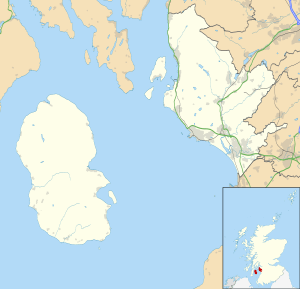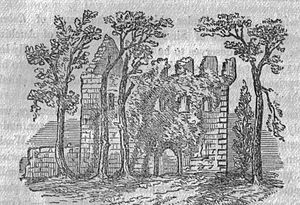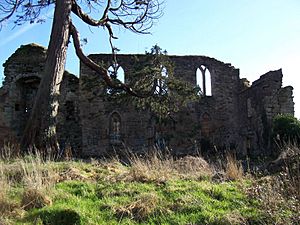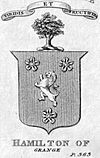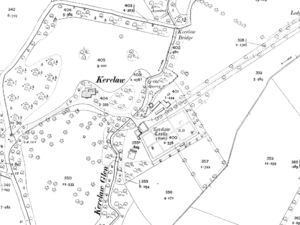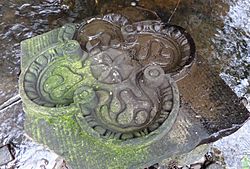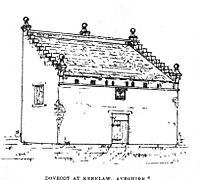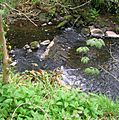Kerelaw Castle facts for kids
Quick facts for kids Kerelaw Castle |
|
|---|---|
| Stevenston, North Ayrshire, Scotland | |
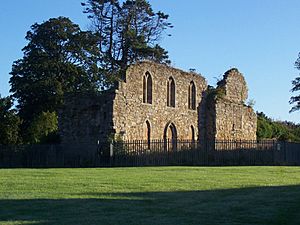
Kerelaw Castle in 2006
|
|
| Coordinates | 55°38′54″N 4°45′08″W / 55.6484°N 4.7523°W |
| Type | Stone |
| Site information | |
| Open to the public |
Yes, with limited access |
| Condition | Ruined |
| Site history | |
| Built | c. 1191, rebuilt after 1488 |
| In use | c. 1191 to 1787 |
Kerelaw Castle is an old ruined castle in Stevenston, Scotland. It sits right on the coast of North Ayrshire. Today, it is owned by a descendant of the Hamilton family, Logan Neely.
Contents
History of Kerelaw Castle
This castle has been called by a few names, like Kerila or Turnlaw. Records show that the Lockhart family owned it as early as 1191. They got the land from Richard de Morville, a powerful Scottish official.
Stephen Lockhart, or Loccard, received a grant of land in Ayrshire. This land was later named Stevenstoune, which became the town of Stevenston. Kerelaw Castle was the main house for this area.
Over time, the castle and land passed to other important families. These included the Campbells of Loudoun and later the Cunninghames of Kilmaurs.
Clan Feuds and Castle Attacks
In 1488, the Cunninghames owned Kerelaw Castle. During a long-running feud between two powerful Ayrshire families, the Montgomeries attacked it. The 2nd Lord Montgomerie led his forces to sack and burn the castle.
Years later, in 1528, the Cunninghames got their revenge. Led by the Earl of Glencairn, they burned Eglinton Castle to the ground. This was the main home of the Montgomerie family.
Kerelaw Castle was rebuilt after the 1488 attack. It is said to have had carved family symbols from Kilwinning Abbey. These symbols belonged to Scottish noble families.
In 1545, nine fishermen from Saltcoats were given special permission to use land. In return, they had to move the Earl's furniture. They carried it from Saltcoats to Finlayston every spring. They brought it back in the autumn when the family returned to Kerelaw. They also had to give the Earl a half-barrel of herrings each year.
Home of the Abbots
Local stories say that Kerelaw Castle was once the home of the Abbot of Kilwinning Abbey. This idea might come from a historical fact. The third son of Alexander Cunningham, the 1st Earl of Glencairn, became a leader at the abbey. He may have lived at Kerelaw after the Reformation.
Later Owners of Kerelaw
In 1609, Sir Thomas Boyd bought the castle. Soon after, he sold it to Sir William Cunninghame. Thirty years later, Sir Robert Cunninghame bought the castle and nearby lands.
In 1655, Alexander Hamilton bought Kerelaw Castle. He was the grandfather of Alexander Hamilton, a famous founding father of the United States. Alexander Hamilton changed the castle's name to Grange. This was after his family home in Kilmarnock.
The Hamilton family lived at Kerelaw, or Grange, until 1787. Another Alexander Hamilton, a cousin of the American politician, built a new house nearby. This new house was called Kerelaw (or Grange) House. After this, the old castle quickly fell into disuse.
In 1797, Alexander Hamilton of Grange helped lay the foundation stone for the new Eglinton Castle. This was done on behalf of the 12th Earl of Eglinton.
Buildings Around the Castle
A dovecote, or doocot, was built near the castle in 1775. This building housed pigeons. It stood until the 1960s when it was taken down.
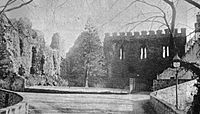
Small cottages for workers were also built in the castle's courtyard. Their unique roof designs added to the castle's old-fashioned look. The castle also had gothic windows, which might have been added in the 1800s. A limekiln, used to make lime, was also located nearby.
Old maps from 1747 show the name as Kerry-law. Other records call it Kerila Castle. A lodge house, east of the castle, is still a private home today.
Final Sale of the Estate
In 1838, after Alexander Hamilton's death, the house, castle, and grounds were sold. Gavin Fullerton bought them. He soon changed the name back to Kerelaw.
Kerelaw Castle Today
Kerelaw Castle is now a ruin. Three of its walls still stand, but they are falling apart. Gothic windows can still be seen on the southern wall. These windows might have been inspired by those at Kilwinning Abbey. This shows that the castle was built at different times in history.
In 1852, a historian noted arrow-slits and old stone carvings. These features suggested parts of the castle were built before the 1300s.
An old bridge, now only for people walking, is next to the ruin. The castle itself is fenced off. This protects people from falling stones and keeps the castle safe. North Ayrshire Council owns the castle and the land around it.
In 2014, some repairs were made to the building. Trees and bushes that were harming the structure were cleared away. A special sign with a QR Code and information about the castle is on the fence.
The bridge has a large hollow space, like a cave, inside it. This once allowed people to use a path along the Stevenston Burn. The bridge's arch shows it was built in two parts. The side facing upstream is newer. A large, fancy carved stone has fallen from the bridge.
The castle once had a walled garden with sundials and beautiful flowerbeds. This area is now a housing estate built in the late 1960s. However, one wall of the old garden still remains. In the 1850s, maps showed an orchard next to the walled garden.
A path made of cobblestones once crossed the Stevenston Burn below the castle. It led up the bank past the Kerelaw Mains farm. Later, limestone mining in the area destroyed this old path. Two footbridges also crossed the burn. One was at a surviving weir, and the other was beyond the quarry house.
Images for kids


